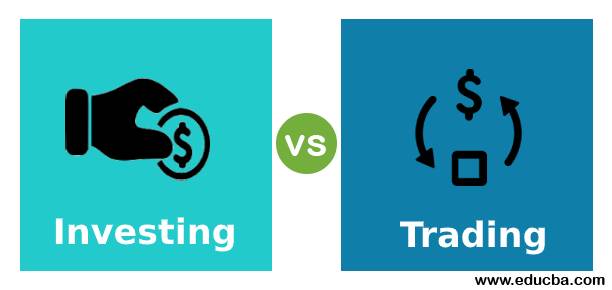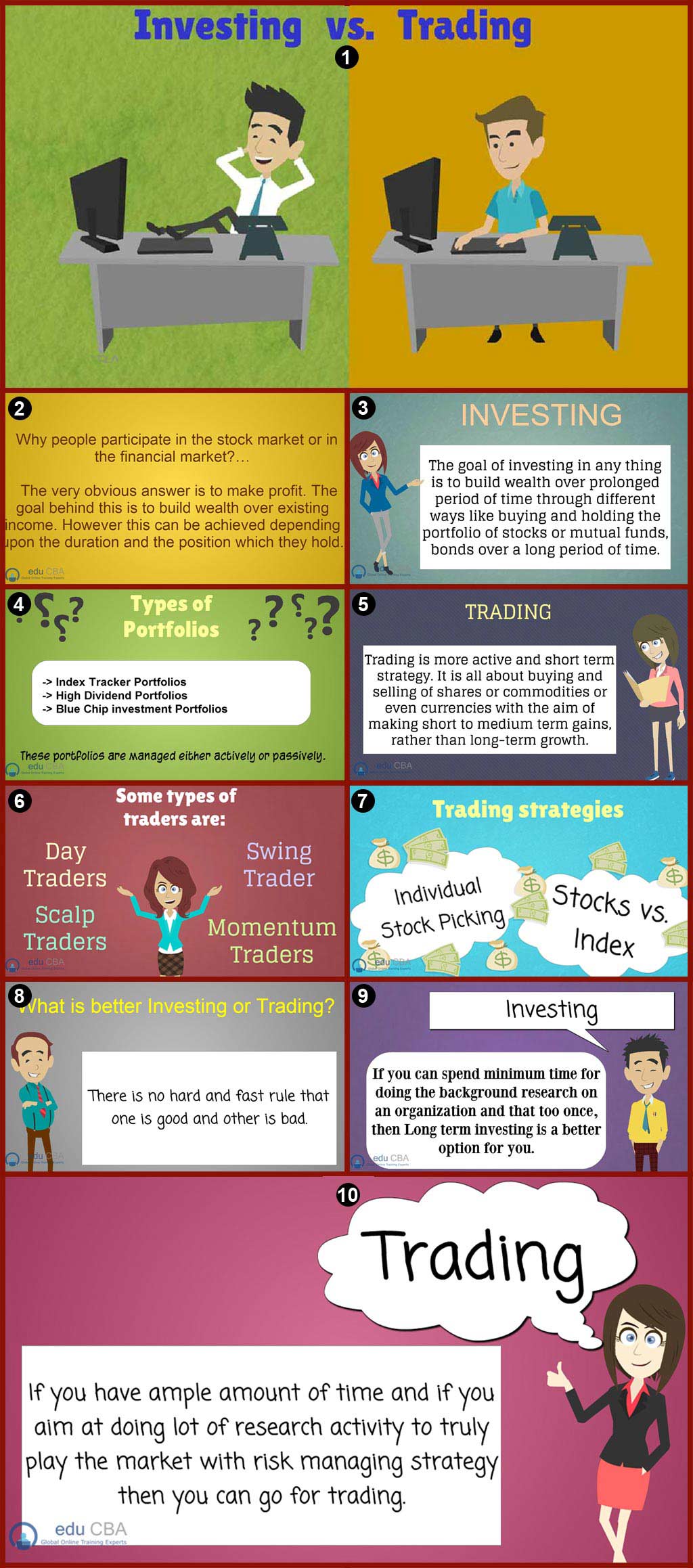Updated October 25, 2023

Investing vs Trading – Why do people participate in the stock or financial market?… The very obvious answer is to make a profit. The goal behind this is to build wealth over existing income. However, depending on their duration and position, Investing vs Trading can be achieved.
Investing vs Trading Infographics
Learn the juice of this article in just a single minute, Investing vs Trading Infographics.
INVESTING
“INVESTMENT “ word is quite lengthy, isn’t it?… Yes, it is. The meaning hidden behind this word is also long as the goal of investing in anything is to build wealth over a prolonged period through different ways, like buying and holding a portfolio of stocks, mutual funds, or bonds over a long period of time.
In polished language, Equity investing involves building a portfolio of stocks and managing its performance for an unbounded period. Thus, suitable market actions are carried out whenever the expected performance is about to be achieved. The time period can be off days, years, or even decades with the advantage of interest, dividends, stock splits, etc. So basically, the main aim is creating an income and achieving growth.
Then how are investors defined? It’s very simple: individuals who make investments are called Investors. These investors enhance their profits by compounding or reinvesting any profits and dividends.
Investors drive toward the downtrends in market fluctuation, hoping to bounce back prices. Thus, research on company fundamentals and other techniques like technical analysis creates a portfolio of different stocks.
Types of Portfolios
Through research and fundamental analysis, one tries to create a balanced portfolio of different stocks.
Some sorts of portfolios are:
Index Tracker Portfolios
This type of portfolio is constructed to track a broad market index or a segment thereof. They invest in all or a representative number of the securities in the index. This portfolio will be set up to follow movements in those indices. E.g., the S&P 500 index. Thus, this kind of investing is known as Passive investing.
High Dividend Portfolios
These portfolios are made up of stocks with above-average dividend yields.
Blue Chip Investment Portfolios
This consists of a highly recognized and financially sound company’s stocks. These blue-chip stocks are a less volatile investment. These portfolios comprise only top-rated stocks.
These Portfolios are Managed Either Actively or Passively
1. Passively Managed Portfolios
In a passive portfolio management strategy, investment is made with a predetermined policy that doesn’t involve any forecasting. Hence, the idea is to minimize investing fees and avoid the adverse consequences of failing to anticipate the future correctly.
An index portfolio, which tracks the index movement as said above, is a kind of passive portfolio management.
2. Actively Managed Portfolios
These portfolios are traded often. The performance is less certain as it depends upon the portfolio manager’s decision-making. The manager adventures market inefficiencies by purchasing securities that are undervalued and short-selling securities that are overvalued.
TRADING
Trading is a more active and short-term strategy. It is about buying and selling shares, commodities, or currencies for short-term gains rather than long-term growth. The basic technique in Trading is buying at a lower market price and selling it at a higher price within a small period or in a reverse way, i.e., selling at a higher price and buying it again at a lower price to profit in dropping markets, which means Short Selling. Traders must also be attentive to make profits within the time frame they want to live in to avoid losses. Hence, they apply a stop-loss strategy to automatically close the losing positions at a predetermined price level.
Traders are classified depending on the holding period or timeframe in which stocks or commodities are bought and sold. They choose their trading style based on factors like the size of the account, time to be involved, risk tolerance capability, personality, and experience level. Thus, traders also use Technical analysis to find high-profitability positions.
Some types of traders are:
Day Traders
These traders buy (or sell) the stocks on any day and close the position for profits on the same day. They do not hold overnight positions.
Scalp Traders
These traders make a number of trades daily, hold positions from seconds to minutes, and try to make a very small profit on each. They will also close the position quickly to limit the losses.
Momentum Traders
These traders look for a situation where a high volume in a stock is moving decisively one way or the other and trade in line with that trend. They will watch for that momentum to ease and then take profits.
Swing Trader
These traders look at the company’s fundamentals and hold positions longer than the other traders but still look for short to medium-term profits and buy and sell actively in the market.
From the above, it can be concluded that whether a day trader or swing trader, a trader is looking to take profits frequently.
Trading strategies
Individual Stock Picking
Individual stock picking is a high-risk-high-return form of Trading. Whether alone or within a portfolio, it requires research to pick the cheapest undervalued stock for buying an overvalued stock for selling.
Stocks vs. Index
These long or short positions are based on index-based portfolios. A contrary view index is also useful for increasing returns.
Market neutral Trading
Market-neutral Trading is a strategy in which a trader seeks to profit from increasing and decreasing prices in single or numerous markets. These traders who hold a market-neutral position can exploit any momentum in the market.
Here is a small table that will give you a snapshot of the difference between investing and trading for beginners.
|
Attributes |
Investing |
Trading |
|---|---|---|
| Duration | Long-Term | Short-term, a few days or even minutes |
| Why | With the belief that the company will do well and generate dividends and increased share price. | A share will move in a certain direction to achieve the target. |
| Objective | Making Money by holding shares. | Making Money with often buying and selling of shares. |
| Analysis Tools | Fundamental analysis | Technical Analysis, Charts. |
| Return Expected | Investors invest with an expectation of a 10 to 15% annual return. | Traders invest with a 10% return each month. |
What is Better, Investing vs Trading?
There is no hard and fast rule that one is good and the other is bad.
It would be best to analyze how much time you intend to spend researching the difference between investing and trading for beginners. As from the above article, you must have understood that the differences between investing and Trading for beginners have their requirements, like doing fundamental analysis, reading the charts, and keeping track of the graphs. So you need to ask yourself how much time you can devote. If you can spend minimum time doing the background research on an organization and that too once, then Long-term investing is a better option for you than Investing vs Trading.
If you have ample time and aim at doing a lot of research activity to play the market with a managing strategy truly, then you can go for Trading. Research entirely involves analyzing the financials of the company, historical price movements, future projections of the financials, etc. So this can be a second job for you as you need a lot of energy and man-hours for dedication. Also, Trading tends to be expensive as every time you buy or sell stocks, you must pay certain fees. For an active trader, these fees add up, and you have to ensure that your returns are high enough to pay your costs; otherwise, your returns will suffer.
Recommended Articles
So here are some that will help you get more details about the difference between investing and Trading, investing vs Trading, investing or Trading, and investing and trading for beginners. So, just go through the link below.






